
Las Vegas once again became the epicenter of horsepower and imagination as the 2025 SEMA Show roared to life inside the Convention Center. For one week, the city’s most famous stretch of neon took a back seat to thousands of builds, tools, and ideas that define where car culture goes next. It was equal parts trade show, festival, and proving ground, a reminder that even as electrification reshapes the industry, the pulse of customization, innovation, and pure mechanical passion is stronger than ever.
From the $337-billion aftermarket’s global leaders cutting the ribbon to Toyota dropping a restomod Land Cruiser with a twin-turbo V6, Tim Kuniskis teasing a Ram reveal “to top the Demon helicopter drop,” and a 550-hp sleeper Odyssey tucked among hyper-polished show cars, SEMA 2025 felt like a statement of identity. The industry isn’t slowing down, it’s diversifying its idea of what performance can be.
The Pulse of the Industry
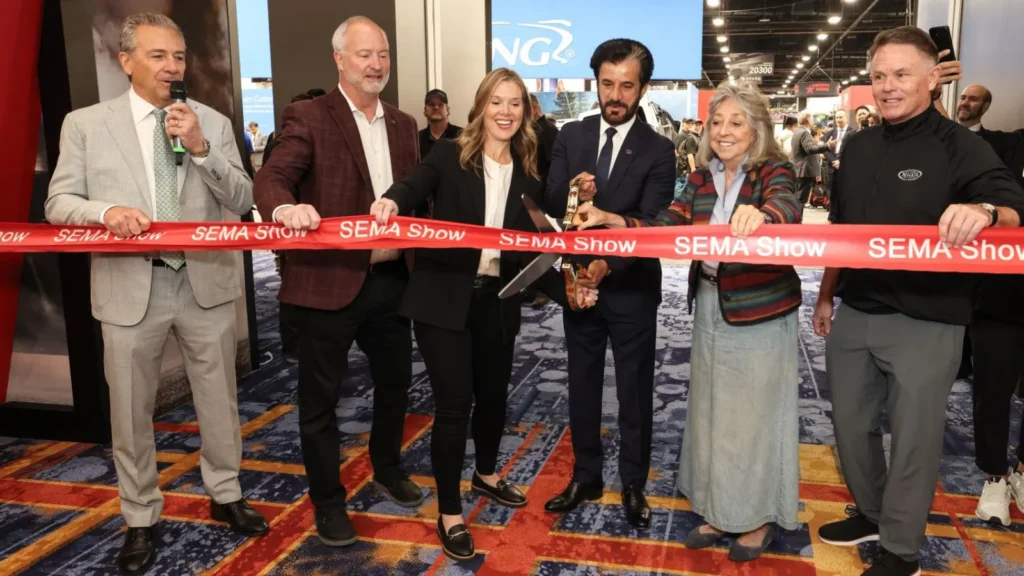
The official opening ceremony captured the scale and momentum of the aftermarket world. SEMA President Mike Spagnola, NHRA’s Glen Cromwell, FIA’s Mohammed Ben Sulayem, and Nevada Rep. Dina Titus joined leaders from across continents to underscore how this event drives more than 1.3 million jobs and $337 billion in U.S. economic activity.
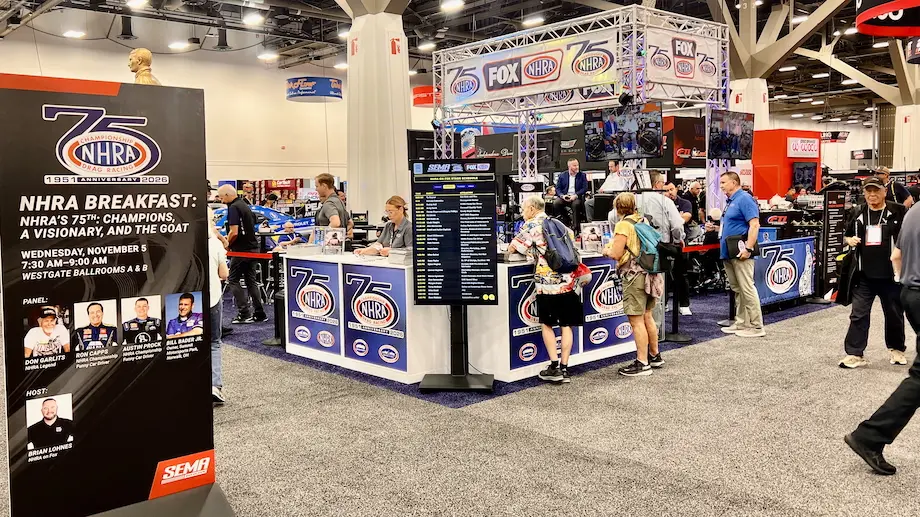
The FutureTech Studio buzzed with demos of ADAS calibrations, synthetic fuels, and hybrid conversions. Meanwhile, NHRA on FOX streamed from its Booth 22,333, turning the drag strip into a content studio for fans watching across the globe. Even as the halls shimmered with carbon fiber and paintwork, the message was clear: this was an ecosystem investing in both performance and practicality.
That same balance echoed in how brands presented themselves. Harbor Freight’s booth, for example, shocked many with its sheer footprint, a display bigger than most of its actual stores. Rows of new ICON G2 ratchets, prototype toolboxes, and expanded power tool displays signaled a brand pivoting from bargain-basement reputation toward professional-grade respectability. Enthusiasts speculated that Harbor Freight might reimagine store formats, possibly creating “halo” locations to showcase their expanding high-end catalog. The buzz wasn’t about hype, it was about a company growing into its own ambition.
OEM Power Plays and a Changing Landscape
SEMA’s big-name presence felt more coordinated this year, with automakers showing both restraint and confidence. Toyota’s trio, the Turbo Trail 60 Series Land Cruiser, Time Attack bZ EV, and Camry GTS Concept, defined the blend of nostalgia and futurism shaping the market. The Land Cruiser restomod carried a modern twin-turbo V6 under classic lines, while the Time Attack bZ previewed an 1,800-pound-downforce electric racer eyeing Pikes Peak. The Camry GTS, built around a hybrid four-cylinder, leaned into the “attainable enthusiast” idea — sporty yet practical, bridging daily life and track-day spirit.
Elsewhere, Infiniti turned heads with the QX80 R-Spec, built around a GT-R-sourced twin-turbo V6 pushing 1,000 horsepower. Hyundai’s Ioniq 9 BigTime Concept embraced the opposite end of the spectrum, a lifted EV adventure build that made the case for electric overlanding.

And then there was Tim Kuniskis, back in the spotlight. The newly reinstated Ram CEO sat on SEMA Live opposite Chris Jacobs, reflecting on his return to Stellantis leadership. Calling it “playing on house money,” he promised to restore the swagger of HEMI, SRT, and NASCAR. His candor hit home across the halls: this was an executive talking like an enthusiast again. With a teased reveal already filmed, almost certainly the 2026 Ram 1500 TRX, Kuniskis’s mission to “bring it all back” gave Mopar loyalists a reason to believe that muscle isn’t just surviving, it’s evolving.
Star Builds and Show Cars
Every corner of the Las Vegas Convention Center told its own story.
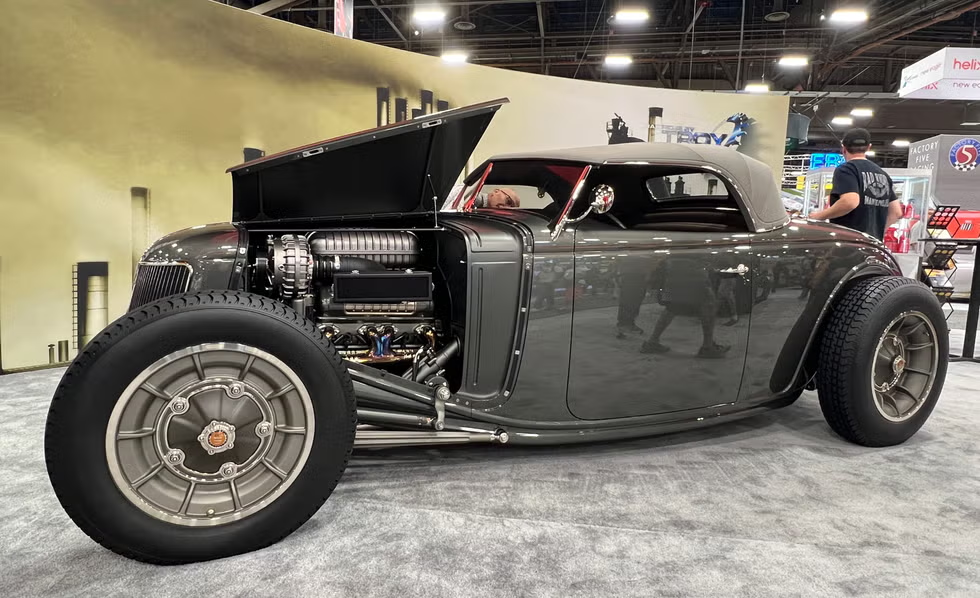
The 1936 Ford Roadster from Rad Rides by Troy balanced old-school polish with 3D-printed Inconel manifolds. Western Iowa Tech’s students earned real respect for their clean, no-gimmick 1972 Chevy K5 Blazer, a build that reminded everyone how sincerity still matters at a show this size. Bisimoto’s Honda Odyssey Type R, a 550-horsepower turbocharged minivan, became an instant talking point for its absurd practicality. Meanwhile, Ron Jones Garage’s VW Thing, now Porsche-powered and off-road capable, proved the small-shop ingenuity that SEMA still thrives on.
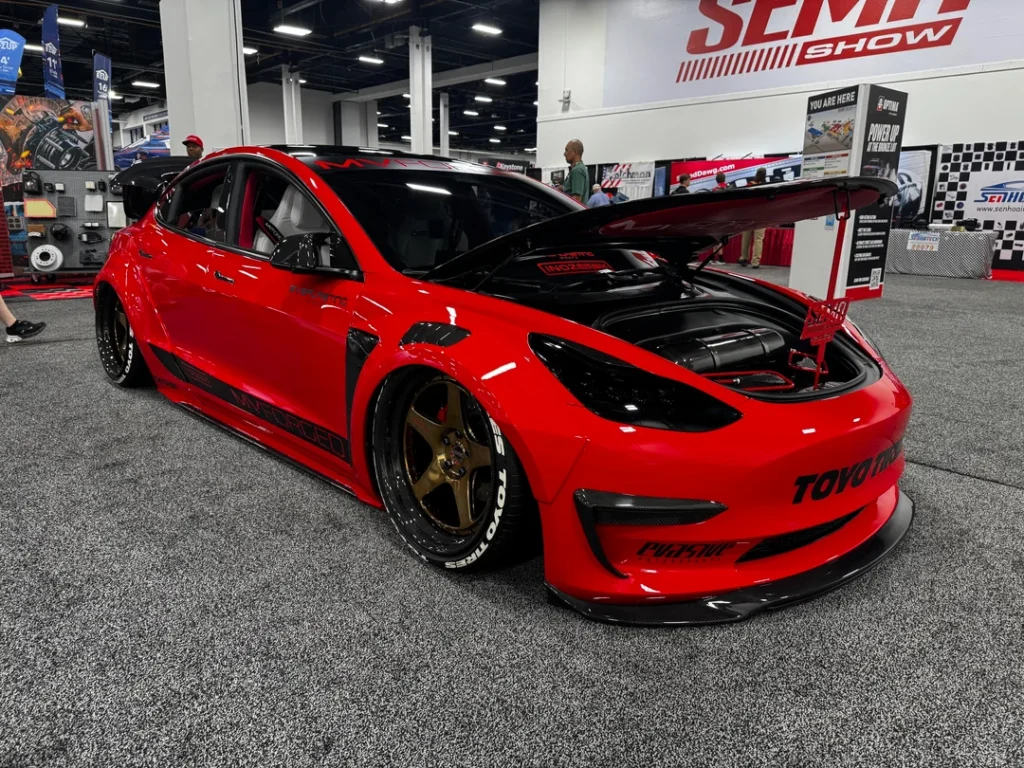
But not every build hit the same chord. The custom Model 3 circulating online drew just as many raised eyebrows as compliments. Some admired its precision and creativity; others saw it as overindulgent, a crypto-era experiment in aesthetic excess. In truth, it embodied what makes SEMA polarizing and vital: the same space that celebrates taste and craft also tests the limits of personal expression. It’s not always pretty, but it’s always bold.
Elsewhere, the Ringbrothers’ Octavia, a carbon-bodied Aston Martin DBS reimagined with a Ford V8, set a new bar for hybridized craftsmanship, the kind of project that outclasses trends and enters mythology.
Overlanding and Real-World Builds
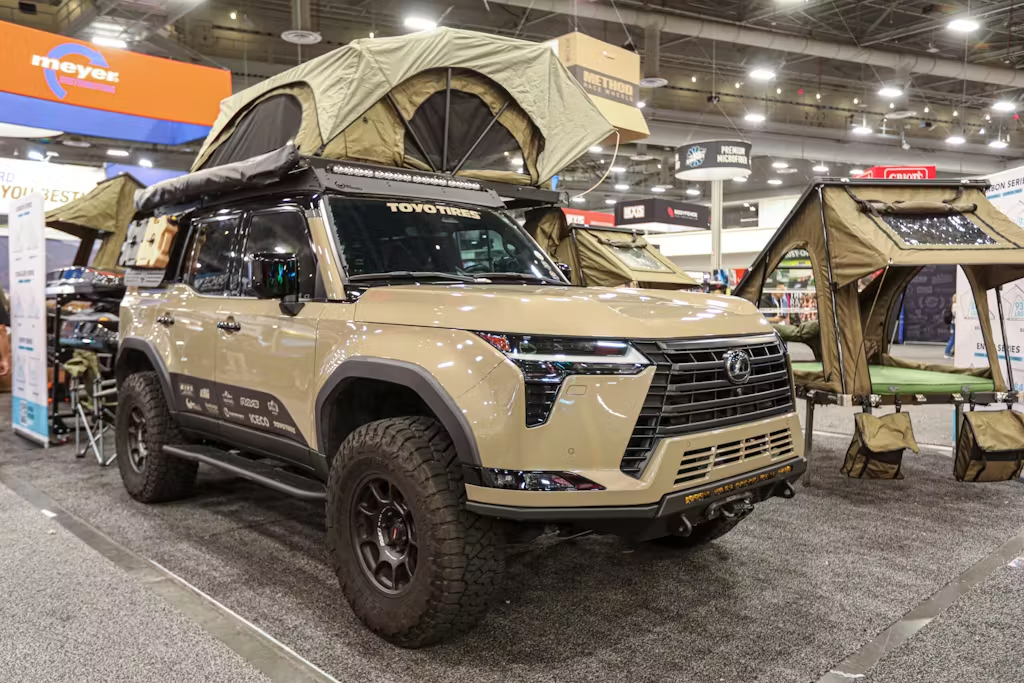
Outdoors, the mood shifted from flash to function. The overlanding area drew crowds as builders blurred the line between utility and artistry.
The Lexus GX 550 “Tannimal” from Inspired Overland hit the sweet spot between rugged and refined, black-and-tan styling, Volk wheels, and a “ready to camp anywhere” demeanor. BuiltRight’s Chevy Colorado Z71 represented a different kind of creativity: minimal aesthetic modification, maximum practicality. It was the kind of understated precision that seasoned off-roaders respect.
The Ram RHO conversion from aFe Power added weight to the argument that performance trucks can go beyond dune-bashing. And between Toyota’s Four Wheel Camper Tundra and Randy’s Worldwide GMC Sierra AT4X, the showcase reminded everyone that the next wave of aftermarket growth may come from those who want to escape the city, not dominate it.
The Tech & Product Pipeline
Beyond the cars, SEMA remains the place where ideas turn into tools. HOT ROD’s product roundup captured how much the ecosystem continues to expand its definition of performance.
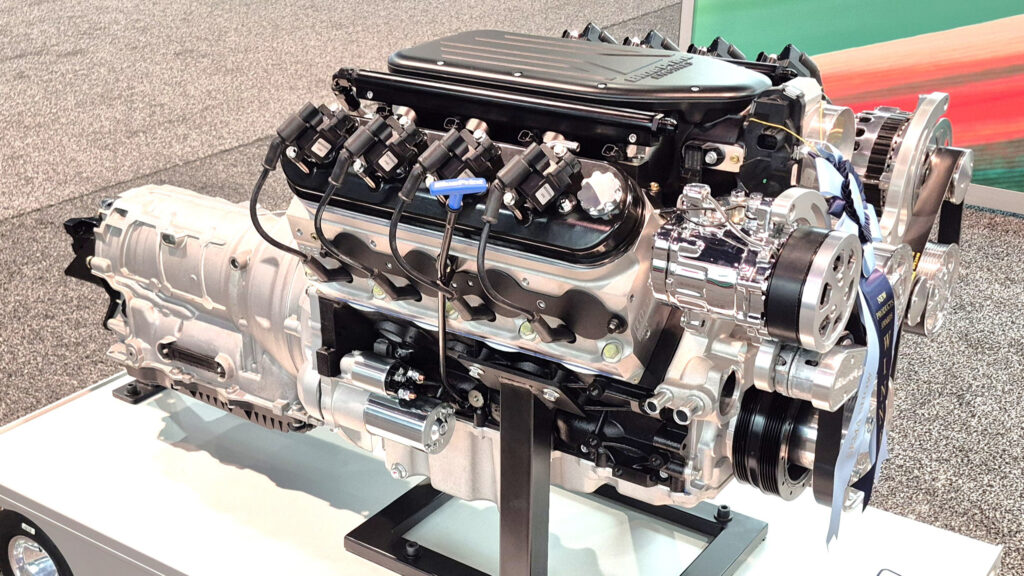
There were mechanical innovations, from ProCharger’s LS intercooler intake and Edelbrock’s LSXR supercharger to Dakota Digital’s Bluetooth-linked mechanical cruise control — all designed to make old-school platforms feel new again. Detroit Speed’s SLA suspension system gave Fox-body Mustangs the handling they always deserved, while BluePrint Engines’ LS+ZF8 combo simplified the engine-swap game for anyone tired of wiring headaches.
But some of the year’s most important advances weren’t about raw speed. Revv’s Integrations Ecosystem, winner of the SEMA New Product Award, quietly redefined how shops communicate. By syncing calibration data directly across existing repair tools and insurer platforms, Revv eliminated repetitive admin work and friction in claims. It’s the kind of behind-the-scenes innovation that keeps the rest of the industry running smoothly.
Meanwhile, across the exhibition floor, Harbor Freight’s expansion signaled a shift in how mainstream brands see their role in pro-grade tooling. Attendees speculated that its massive booth, filled with prototype storage systems and upgraded ICON equipment, reflected a growing ambition to compete head-to-head with premium toolmakers. The energy felt less about discount retail and more about accessibility: professional-quality gear for every builder.
Human Stories and Culture
SEMA’s reach extends far beyond commerce. Midweek, seven Las Vegas residents, including veterans and caregivers, received refurbished vehicles through a local charity program. One mother, whose car had been stolen twice while she was undergoing cancer treatment, called the gift life-changing. These moments, quietly unfolding away from the main stage, grounded the event’s spectacle in something deeper: the belief that mobility and community are inseparable.
At the same time, NHRA’s live broadcast kept the culture side thriving. Drag racers, builders, and fans mingled freely as the sport’s legends discussed the next generation of performance tech. Later in the week, SEMA Fest took over, blending live music from Queens of the Stone Age, The Black Crowes, and Neon Trees with motorsport demos and fan activations — a deliberate bridge between passion and business.
What It Means
If 2024 was a year of hesitation, one foot in tradition, one toe in electrification, SEMA 2025 was the year the industry rediscovered its confidence. The halls proved that combustion, electrification, and hybrid creativity can coexist, not as rivals, but as different expressions of the same drive to build.
Harbor Freight’s unexpected dominance, Toyota’s blend of nostalgia and innovation, Kuniskis’s vow to reignite muscle performance, and the Model 3 controversy all underscored the same truth: this community thrives on experimentation. It doesn’t always land, but it never stops moving.
Every year, the show reminds us that car culture isn’t just about what’s fast or loud, it’s about evolution. And judging from the energy in Las Vegas this November, the aftermarket’s next era isn’t approaching. It’s already here, still wild, still divided, and absolutely alive.
